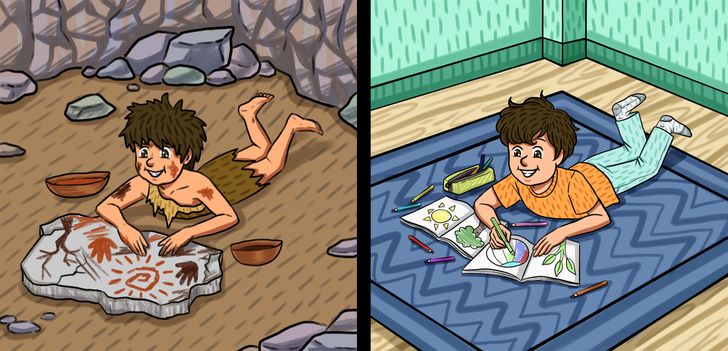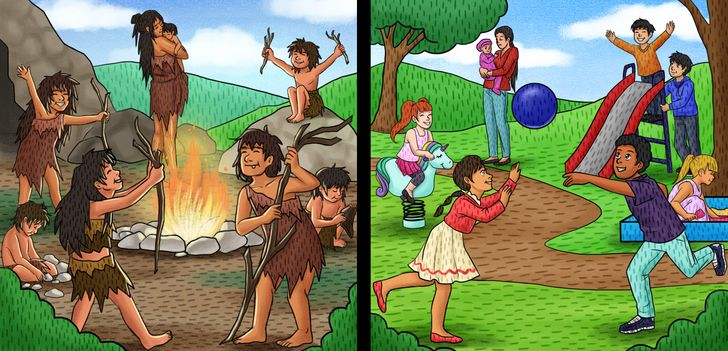20 People Who Are Way Ahead of Their Time


The human race has come a long way from the rudimentary necessities of the Stone Age. And yet, some things never change, like the love a parent has for their child. The tools of parenting have changed, of course, but the instinct remains the same. Today’s children may draw on beautiful art pads and electronic tablets, but it all started with soft clay and caves a long time ago.
Bright Side took a deep dive into the not-so-easy lives of Stone Age parents. We were blown away to find out that many of today’s parenting techniques and principles have carried over from the dawn of civilization.

We often use art today as learning tools for children to help them express not just their creativity but also their feelings. Today, we have coloring books and a zillion different types of coloring tools. But even Stone Age children were encouraged to draw as is apparent by cave art found in France. The flutings discovered in these caves show that children were encouraged to run their fingers through soft clay, making crisscrossing lines, zig-zags, and swirls.
In fact, one of the chambers found in this mammoth cave system is rich in drawings, only by children. This led experts to believe that prehistoric children attended some sort of nursery, helping them nurture their drawing talent.

Many mothers practice extended breastfeeding today, letting children nurse till the age of 3-4. Some practice baby-led weaning, meaning it’s the baby who decides that they have had enough of nursing. As it turns out, the women who do this today are just going back to their roots.
A study has pointed out that Stone Age mothers tended to breastfeed their children longer, till the ages of 3-4. This may have led to better brain development in humans and better immunity as well.

Babies do not like to be left alone, and most parents have a cartload of chores to attend to during the day. A simple solution to keep the baby happy and the parent guilt-free is to carry the baby while you work. Today, we have all sorts of ergonomic baby carriers and slings that help us do the job. Experts also recommend skin-to-skin contact with your infant, believing it makes them better-balanced adults.
And there is plenty of evidence that pre-historic parents also carried their infants when they went around doing their chores because it was convenient. Plus, this was one way to protect babies from the many predators around.

Today’s children have toys, like plastic swords, NERFs, and other role-play creations. And if left alone, children of all ages tend to play together and get along well. Alternative streams of education, like Montessori and Waldorf, encourage multi-age play.
And this is exactly how the pre-historic children got along. The school consisted of children of all ages getting together to play, and toys were age-appropriate tools and weapons. Not only did this keep the children occupied, but it also trained them for adult life back in the Stone Age.

In today’s increasingly distant and nuclear families, children are missing out on spending time with their elders. And yet, in many families where the parents are absent due to various reasons, it’s the grandparents who turn into primary caregivers. Even in close-knit families, if the parents are out, it’s the elders of the family that take care of the kids.
And this happened in pre-historic times as well. Most of the adults, especially the elderly who were not so active in hunting and gathering because of age, became designated as caregivers. The wisdom they passed on helped the human race thrive.

There are many mothers today who struggle with breastfeeding for a myriad of reasons. And as it turns out, paleolithic mothers faced similar challenges as well. This is why the earliest baby bottles, which were made of clay, have been dated to 5,000 years ago.
Prehistoric baby bottles became more common in the Iron and Bronze Ages, and residue in them points to animal dairy. Human beings have always been innovative when it comes to doing the best for their children. Here’s a picture of a baby bottle from the Bronze Age, dating from 1350 BCE to 800 BCE.

Prehistoric parents did not seem to believe in corporal punishment or spanking, as several studies have pointed out. Most of the Stone Age child-rearing points to attachment parenting. Children were cuddled, carried, held, hugged, and more likely to be gently scolded rather than spanked for misbehaving.
Today’s child psychologists also believe that hitting a child is detrimental to his or her mental health and balance, even as an adult. So the early humans knew a lot about raising children right.

Some experts believe in the cry-it-out sleep training method. They advocate that if infants are full, changed, comfortable and dry, they should sleep on their own. If the infant fusses and cries, leaving them alone, even if they cry, is a way to make them self-reliant. There is some proof of the veracity of the belief. Other experts do not advise it.
For Stone Age parents, this was an absolute no. If a child cried, the parents or caregivers would respond immediately. The child would be cuddled and handled with affection. There is proof that children who receive affection learn to self-soothe sooner.

Art discovered in various caves around the world point to something else that was a communal effort. Children were given a free hand to draw what they liked but also guided into drawing shapes correctly. Today, we hold the hands of our children to help them write and get the alphabet correct.
Back then, the flutings of a 2-year-old child show that there were an adult hand-guiding their markings. So art was used to teach constructively and help the child become confident. Many experts believe that when it came to Stone Age children, there was very little that they weren’t allowed to do.
What parenting techniques from the past surprised you the most? Do you know of any such ancestral parenting tips and tricks from your side of the world?
Got some cool photos or stories and want to be featured on Bright Side? Send them all right HERE and right now. Meanwhile, we’re waiting!











